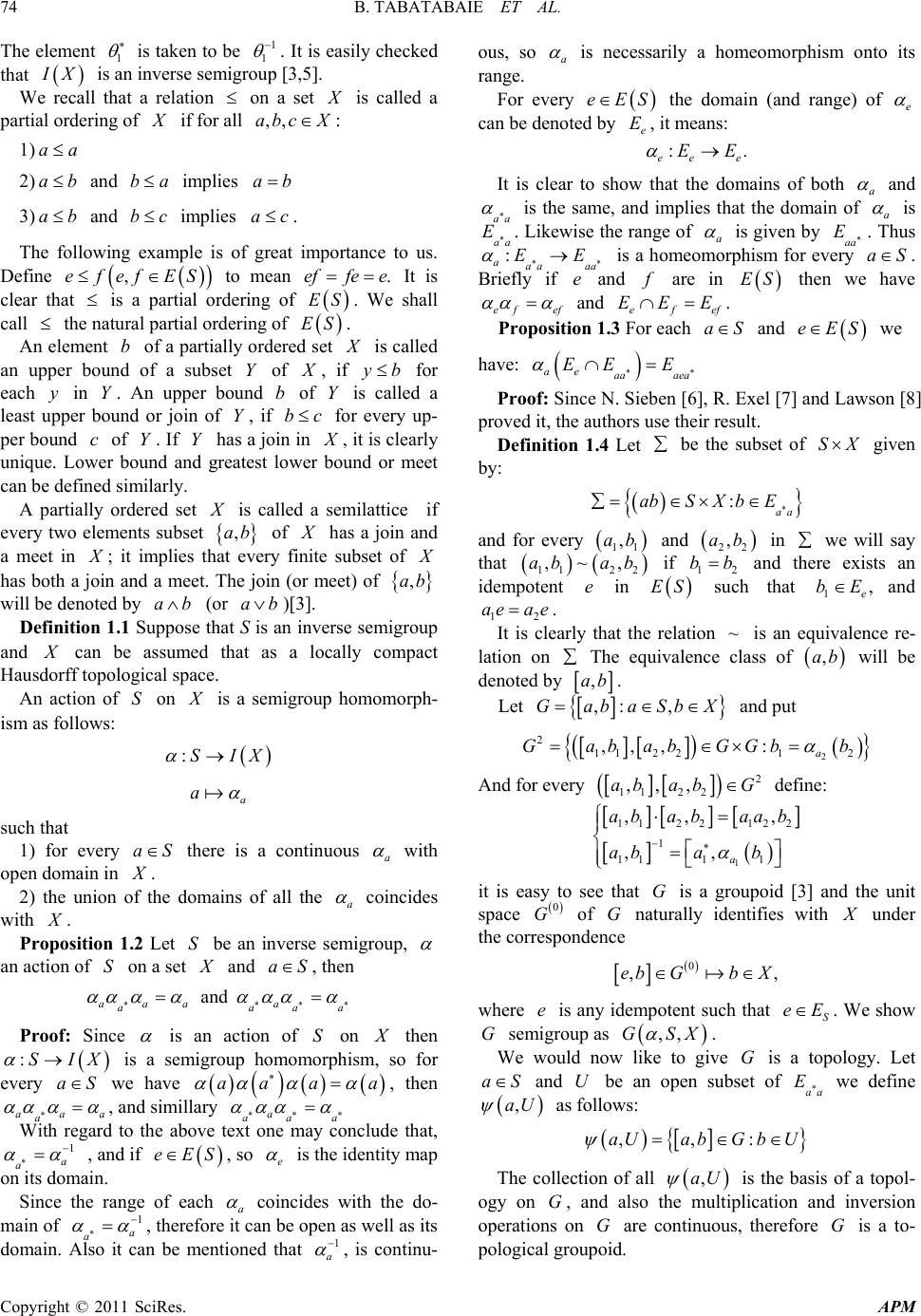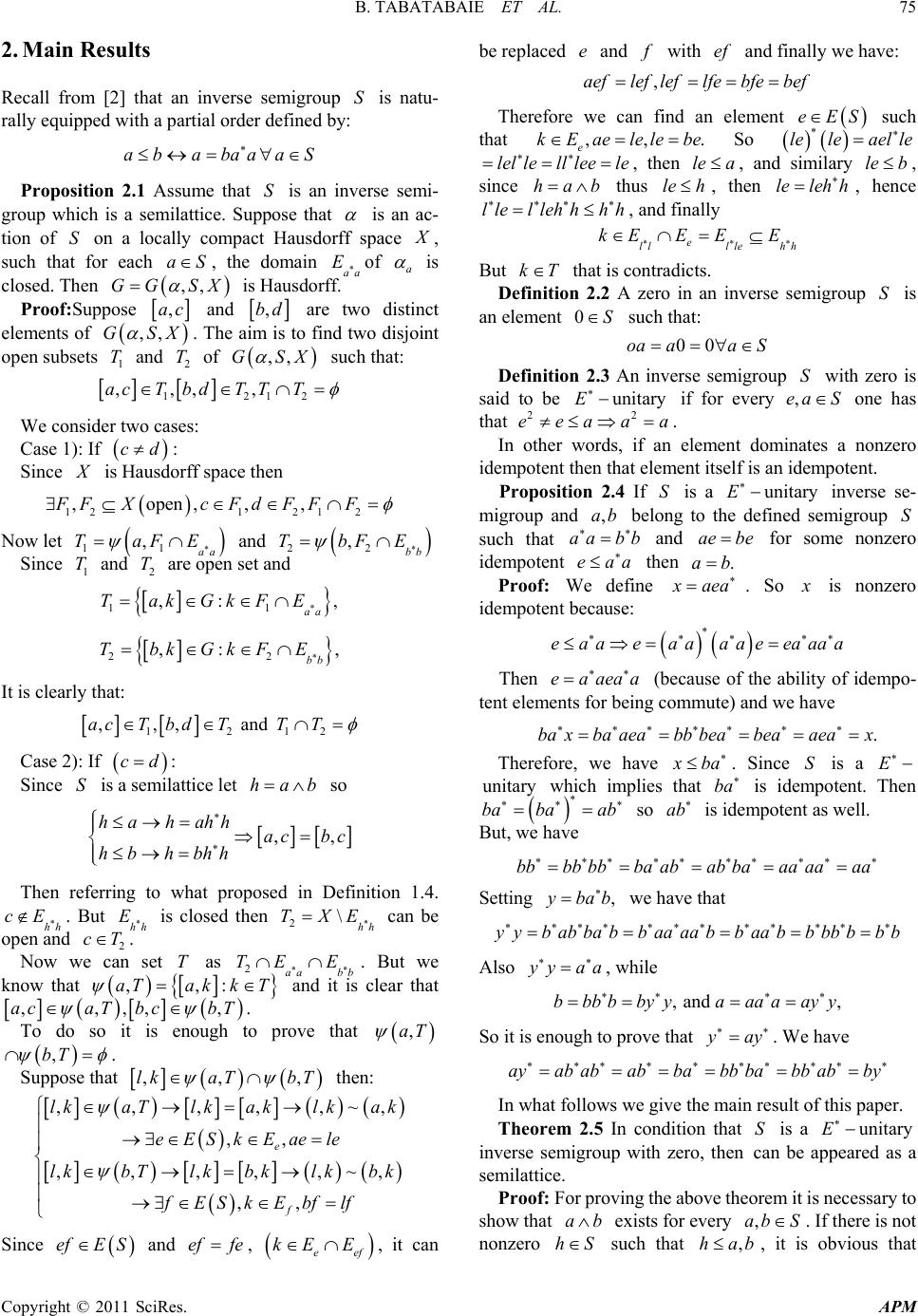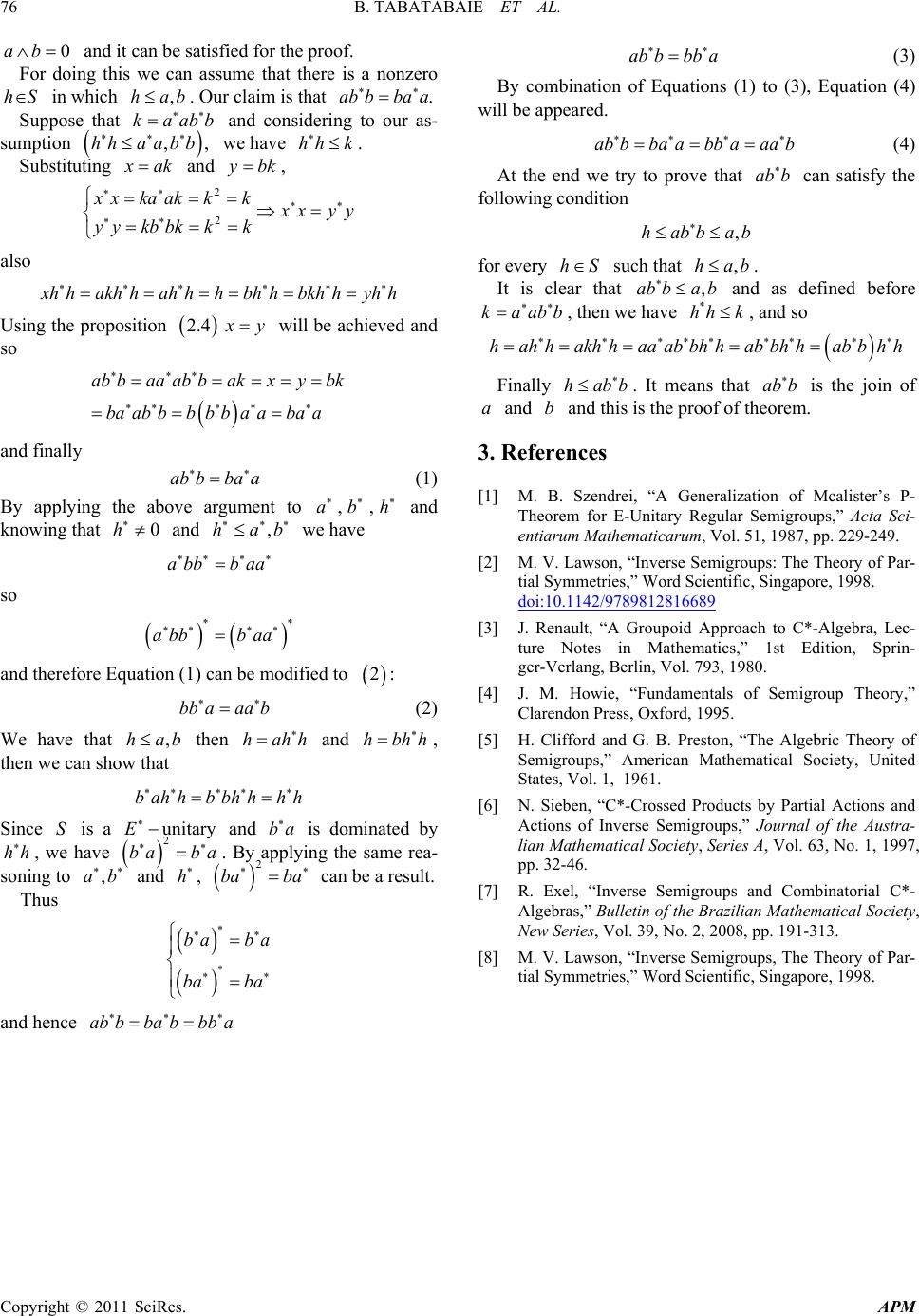Paper Menu >>
Journal Menu >>
 Advances in Pure Mathematics, 2011, 1, 73-76 doi:10.4236/apm.2011.13016 Published Online May 2011 (http://www.scirp.org/journal/apm) Copyright © 2011 SciRes. APM A Study on the Conversion of a Sem igroup to a Semilattice Bahman Tabatabaie, Seyed Mostafa Zebarjad Department of Mat hematics, Shiraz University, Shiraz, Iran E-mail: s_zebarjad@yahoo.com Received January 19, 2011; revised March 15, 2011; accepted March 25, 2011 Abstract The main aim of the current research has been concentrated to clarify the condition for converting the inverse semigroups such as S to a semilattice. For this purpose a property the so-called *unitaryE has been de- fined and it has been tried to prove that each inverse semigroups limited with *unitaryE show the specifi- cation of a semilattice. Keywords: Semigroup, Semilattice, *unitaryE 1. Introduction 1.1. Literature Survey Literature survey done by th e authors show that a special class of semigroups possessing is formed by the * E unitary inverse semigroups, sometimes also called 0 *unitaryE, which was defined by Szendrei [1] and has been intensely studied in the semigroup literature. See, for example, Kellendonk’s topological groupoid is Hausdorff when S is *unitaryE[2], and the related class of unitaryE inverse semigroups have also been shown to prov ide Hausdorf f groupoids [3 ]. In the current research the authors try to prove that each inverse semi- groups limited with *unitaryE show the specification of a semilattice. For this purpose, firstly we present ele- mentary concepts as follows. 1.2. Preliminary Definitions and Propositions A groupoid is a set G together with a subs et 2 GGG , a product map ,ab ab. From 2 G to G, and an inverse map 1 aa (so that 1 1 aa ) from G onto G such that: 1) if 2 ,,, ,ab bcG then 2 ,,,ab ca bcG and ab cabc. 2) 12 ,bb G for all bG , and if 2 ,ab G then 1 aabb and 1.ab ba Note that 2 G is nothing but the set of all pairs , x y in GG for which x y is defined, and 2 G is called the set of composable pairs of the groupoid G[3]. If 1 , x Gd xxx is the domain of x and 1 rx xx is its range. The pair , x y is composable if and only if the range of y is the domain of x . 0 GdGrG is the unit space of G, its elements are units in sense that d x xx and rx x [4]. By an inverse semigroup we mean a semigroup S such that for each a in S, there exists a unique ele- ment a in S with the following properties: ,aa aa and aaa a It is well known that the correspondence aa is an involutive anti-homomorphism, i.e., abb a for all a and b in S. It is very common to denote it by ES, the set of all idempotent elements of S, it means that 2 aa for all a in ES. It is clear that aa for all a in ES. A very important example of an inverse semigroup is given by SIX the set of all partial one-to-one maps on a set X . So each element of I X is a bijec- tion form a subset U of X onto another subset V of X . The set I X is a semigroup where the multi- plication rule is given by composition of partial maps with the largest possible domain. For example, if 12 , I X with 11 1 :UV and 22 2 :UV , then 1 122211 21 :VU VU is given by: 121 2.aa  B. TABATABAIE ET AL. Copyright © 2011 SciRes. APM 74 The element 1 is taken to be 1 1 . It is easily checked that I X is an inverse semigroup [3,5]. We recall that a relation on a set X is called a partial ordering of X if for all ,,abc X: 1) aa 2) ab and ba implies ab 3) ab and bc implies ac. The following example is of great importance to us. Define ,efefES to mean .effe e It is clear that is a partial ordering of ES. We shall call the natural partial ordering of ES. An element b of a partially ordered set X is called an upper bound of a subset Y of X , if yb for each y in Y. An upper bound b of Y is called a least upper bound or join of Y, if bc for every up- per bound c of Y. If Y has a join in X , it is clearly unique. Lower bound and greatest lower bound or meet can be defined sim i l a rly. A partially ordered set X is called a semilattice if every two elements subset ,ab of X has a join and a meet in X ; it implies that every finite subset of X has both a join and a meet. The join (or meet) of ,ab will be denoted by ab (or ab)[3]. Definition 1.1 Suppose that S is an inverse semigroup and X can be assumed that as a locally compact Hausdorff topological space. An action of S on X is a semigroup homomorph- ism as follows: :SIX a a such that 1) for every aS there is a continuous a with open dom a i n in X . 2) the union of the domains of all the a coincides with X . Proposition 1.2 Let S be an inverse semigroup, an action of S on a set X and aS, then and aaa a aaaa Proof: Since is an action of S on X then :SIX is a semigroup homomorphism, so for every aS we have aa aa , then aaa a , and simillary a aaa With regard to the above text one may conclude that, 1 a a , and if eES, so e is the iden tity map on its domain. Since the range of each a coincides with the do- main of 1 a a , therefore it can be open as well as its domain. Also it can be mentioned that 1 a , is continu- ous, so a is necessarily a homeomorphism onto its range. For every eES the domain (and range) of e can be denoted by e E, it means: :. ee e EE It is clear to show that the domains of both a and aa is the same, and implies that the domain of a is aa E . Likewise the range of a is given by aa E . Thus : aaa aa EE is a homeomorphism for every aS . Briefly if e and f are in ES then we have ef ef and efef EEE . Proposition 1.3 For each aS and eES we have: ae aa aea EE E Proof: Since N. Sieben [6], R. Ex el [7] and Lawson [8 ] proved it, the author s use their result. Definition 1.4 Let be the subset of SX given by: :aa abSXbE and for every 11 ,ab and 22 ,ab in we will say that 112 2 ,~,abab if 12 bb and there exists an idempotent e in ES such that 1, e bE and 12 ae ae . It is clearly that the relation ~ is an equivalence re- lation on The equivalence class of ,ab will be denoted by ,ab . Let ,: ,GabaSbX and put 2 1122 212 ,,,:a ab abGGGbb And for every 2 112 2 ,,,ab abG define: 1 112 212 2 1 111 1 ,, , ,, a ab abaab aba b it is easy to see that G is a groupoid [3] and the unit space 0 G of G naturally identifies with X under the correspondence 0 ,,eGbbX where e is any idempotent such that S eE. We show G semigroup as ,,GSX . We would now like to give G is a topology. Let aS and U be an open subset of aa E we define ,aU as follows: ,,:aUabGbU The collection of all ,aU is the basis of a topol- ogy on G, and also the multiplication and inversion operations on G are continuous, therefore G is a to- pological grou poid.  B. TABATABAIE ET AL. Copyright © 2011 SciRes. APM 75 2. Main Results Recall from [2] that an inverse semigroup S is natu- rally equipped with a partial order defined by: ab abaaaS Proposition 2.1 Assume that S is an inverse semi- group which is a semilattice. Suppose that is an ac- tion of S on a locally compact Hausdorff space X , such that for each aS, the domain aa Eof a is closed. Then ,,GG SX is Hausdorff. Proof:Suppose ,ac and ,bd are two distinct elements of ,,GSX . The aim is to find two disjoint open subsets 1 T and 2 T of ,,GSX such that: 1212 ,,, ,acTbdT TT We consider two cases: Case 1): If cd: Since X is Hausdorff space then 12121 2 ,open,,,FFXc FdFFF Now let 11 ,aa TaFE and 22 ,bb TbFE Since 1 T and 2 T are open set and 11 ,: , aa TakGkFE 22 ,: , bb TbkGkFE It is clearly that: 1212 ,,, andacTbdTTT Case 2): If cd: Since S is a semilattice let hab so ,, ha hahhac bc hb hbhh Then referring to what proposed in Definition 1.4. hh cE . But hh E is closed then 2\hh TXE can be open and 2 cT. Now we can set T as 2aa bb TE E . But we know that ,:,kTa Tak and it is clear that ,,,,,acaT bcbT . To do so it is enough to prove that ,aT ,bT . Suppose that ,, ,lk aTbT then: ,,,,,~, ,, ,,,,,~, ,, e f lkaTlk aklkak eESk Eaele lkbTlk bklkbk fESkEbflf Since efE S and ef fe, eef kE E , it can be replaced e and f with ef and finally we have: ,aeflefleflfebfebef Therefore we can find an element eES such that ,,. e kEae lele be So leleael le lellellleele , then lea, and similary le b , since hab thus le h , then leleh h , hence lle llehh hh , and finally e lllle hh kEE EE But kT that is contradicts. Definition 2.2 A zero in an inverse semigroup S is an element 0S such that: 00oa aa S Definition 2.3 An inverse semigroup S with zero is said to be unitaryE if for every ,ea S one has that 22 eeaaa . In other words, if an element dominates a nonzero idempotent then that element itself is an idempotent. Proposition 2.4 If S is a unitaryE inverse se- migroup and ,ab belong to the defined semigroup S such that aa bb and ae be for some nonzero idempotent eaa then . ab Proof: We define x aea . So x is nonzero idempotent because: * e aaeaaaae eaaaa Then eaaeaa (because of the ability of idempo- tent elements for being commute) and we have .baxba aeabb beabeaaeax Therefore, we have x ba . Since S is a E unitary which implies that ba is idempotent. Then ba baab so ab is idempotent as well. But, we have bbbb bbbaabab baaa aaaa Setting , y ba b we have that y yb ab ba bb aaaa bb aa bbbb bbb Also y yaa , while ,and ,bbbbby yaaaaay y So it is enough to prove that y ay . We have ayabababbabb babb abby In what follows we give the main result of this paper. Theorem 2.5 In condition that S is a unitaryE inverse semigroup with zero, thencan be appeared as a semilattice. Proof: For proving the above theorem it is necessary to show that ab exists for every ,ab S. If there is not nonzero hS such that ,hab, it is obvious that  B. TABATABAIE ET AL. Copyright © 2011 SciRes. APM 76 0 ab and it can be satisfied for the proof. For doing this we can assume that there is a nonzero hS in which ,hab. Our claim is that .ab bba a Suppose that kaabb and considering to our as- sumption ,,hh aabb we have hh k . Substituting x ak and ybk, 2 2 xx kaakkk x xyy yy kbbkkk also x h hakh hah hhbh hbkh hyh h Using the proposition 2.4 x y will be achieved and so ab baa ab bakxybk baabbbbbaabaa and finally ab bba a (1) By applying the above argument to a,b,h and knowing that 0h and ,hab we have abb baa so ** abb baa and therefore Equation (1) can be modified to 2: bb aaa b (2) We have that ,hab then hahh and hbhh , then we can show that bahh bbhh hh Since S is a unitaryE and ba is dominated by hh , we have 2 baba . By applying the same rea- soning to ,ab and h, 2 ba ba can be a result. Thus * baba ba ba and hence abb babbba ab bbb a (3) By combination of Equations (1) to (3), Equation (4) will be appeared. ab bba abbaaa b (4) At the end we try to prove that ab b can satisfy the following condition ,habbab for every hS such that ,hab. It is clear that ,ab bab and as defined before kaabb , then we have * hh k, and so hahhakh haaab bh hab bhhab bhh Finally habb . It means that abb is the join of a and b and this is the proof of theorem. 3. References [1] M. B. Szendrei, “A Generalization of Mcalister’s P- Theorem for E-Unitary Regular Semigroups,” Acta Sci- entiarum Mathematicarum, Vol. 51, 1987, pp. 229-249. [2] M. V. Lawson, “Inverse Semigroups: The Theory of Par- tial Symmetries,” Word Scientific, Si ngapore, 1998. doi:10.1142/9789812816689 [3] J. Renault, “A Groupoid Approach to C*-Algebra, Lec- ture Notes in Mathematics,” 1st Edition, Sprin- ger-Verlang, Berlin, Vol. 793, 1980. [4] J. M. Howie, “Fundamentals of Semigroup Theory,” Clarendon Press, Oxford, 1995. [5] H. Clifford and G. B. Preston, “The Algebric Theory of Semigroups,” American Mathematical Society, United States, Vol. 1, 1961. [6] N. Sieben, “C*-Crossed Products by Partial Actions and Actions of Inverse Semigroups,” Journal of the Austra- lian Mathematical Society, Series A, Vol. 63, No. 1, 1997, pp. 32-46. [7] R. Exel, “Inverse Semigroups and Combinatorial C*- Algebras,” Bulletin of the Brazilian Mathematical Society, New Series, Vol. 39, No. 2, 2008, pp. 191-313. [8] M. V. Lawson, “Inverse Semigroups, The Theory of Par- tial Symmetries,” Word Scientific, Singapore, 1998. |

